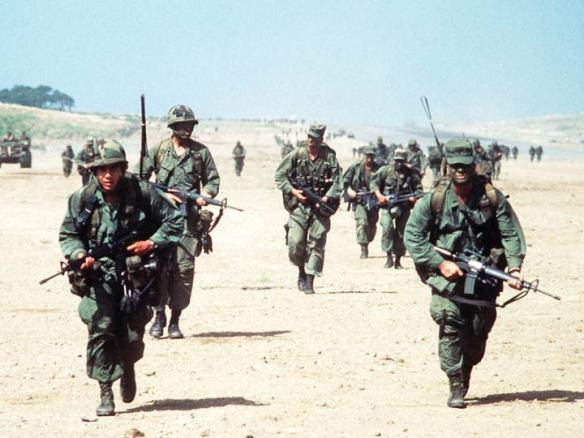Snatching Victory from the Jaws of Defeat
The 1983 invasion of Grenada was hailed as an American comeback. But it was nearly a military debacle.
In October 1983, U.S. forces invaded the small Caribbean island nation of Grenada for what was described as the rescue of American citizens.
After three days of combat, American troops secured the island. President Ronald Reagan said of Operation Urgent Fury: “Our days of weakness are over. Our military forces are back on their feet and standing tall.”
In fact, Urgent Fury was a confused, poorly planned, and poorly executed military operation. Prepared in haste, it was crippled by poor joint coordination, equipment failures, and unexpected hard resistance from Grenadian soldiers and their Cuban allies. It was only the quick thinking of the troops on the ground that prevented Urgent Fury from becoming one of America’s greatest military debacles.
Grenada, a one-time British colony, was largely unknown to Americans. On October 13, 1983, the pro-communist Bernard Coar and his Provisional Revolutionary Army (PRA) overthrew the island’s government. Coar jailed the island’s governor-general, Sir Paul Scoon.
On October 22, with the encouragement of the Organization of Eastern Caribbean States, Reagan ordered execution of Operation Urgent Fury to rescue nearly 600 American medical students living on the island.
Joint Operation
Urgent Fury came under the auspices of Admiral Wesley L. McDonald’s Atlantic Command. Because it was a joint operation, missions were largely chosen to make sure each service got a target, even if they were militarily insignificant.
The 22nd Marine Amphibious Unit was charged with assaulting Pearls Airport and the town of Grenville on the island’s east coast.
To the south, two reduced-strength Ranger battalions would take the Point Salines airport. Following the Rangers in at Salines would be elements of the 82nd Airborne Division.
Navy SEALs were tasked with infiltrating the Point Salines Airport, clear it of obstructions, and help an Air Force combat air control team set up beacons to guide the transports bearing the Rangers to the airport. The SEALs were also tasked with rescuing General Governor Scoon.
The Army’s Delta Force was given the questionable mission of capturing Richmond Hill Prison, where the PRA held political prisoners.
D-Day was October 25. H-Hour 0200.
Things went wrong immediately.
SEAL Team Drowns
One of the SEAL teams drowned after parachuting into the sea off Point Salines. Another, with the Air Force team, was swept out to sea after its assault boat swamped and the motor died. They were eventually rescued by a Navy ship.
A second attempt to infiltrate the airport pushed H-Hour back to 0500. That attempt also failed.
As the Rangers approached the airport, they learned of the failure of the SEAL teams. Rather than land, the Rangers would now parachute into the airport.
Failure of navigation equipment on one of the transport planes caused the Rangers further delay, losing them the cover of darkness. It also caused the air drop to take an hour and a half to complete, when it should have taken only minutes.
The Rangers secured the airport and pushed eastward toward True Blue campus, encountering stiff PRA resistance as they advanced. At first, the Rangers couldn’t talk to their supporting Marine Cobra helicopter gunships. Then coordinating targets was hampered because the Rangers and Marines used different maps. At one point, a forward air controller used a mirror to target a house concealing a recoilless rifle.
Meanwhile, a Navy SEAL team became trapped by PRA troops after rescuing Governor-General Scoon. Then-Major General H. Norman Schwarzkopf hastily organized their rescue by helicopter. The operation earned Schwarzkopf an instant appointment as deputy commander of Urgent Fury.
The Rangers secured True Blue campus at about 0800, then learned most of the American students lived at another campus, called Grand Anse, two miles to the north in an area controlled by Cuban and PRA troops
Schwarzkopf organized a hasty assault on Gran Anse. Marine helicopters picked up the Rangers at Point Salines and landed them at Gran Anse behind the enemy’s lines. The raid succeeded in rescuing 224 students without any civilian casualties and only one wounded Ranger.
Disaster at Calivigny
The Ranger’s next objective was Camp Calivigny. The PRA barracks had no strategic value, but was consider an imperative target by the Joint Chiefs of Staff in Washington. Like so much that came from Washington during Urgent Fury, the orders lead to near disaster.
The first helicopter assault wave, lacking adequate intelligence, overshot the LZ. One suffered damage on landing, and careened into a second. A third crashed into a ditch. Three Rangers were killed and four wounded. The surviving Rangers found the camp deserted.
Poor intelligence led to a similar disaster during the assault on Richmond Hill Prison. Helicopters carrying Delta Force and Rangers were hit with devastating anti-aircraft fire, and turned back.
After three days of fighting and several more of mopping up, official casualties for U.S. troops included 19 dead and 152 wounded. Twenty-four Cubans died in the fighting, and 59 wounded. PRA casualty figures are not known.
Afterward, the planning and execution of Urgent Fury came under attack. Among the critics was Schwarzkopf, who credited the troops with snatching victory from the jaws of defeat.
“Even though higher HQ screws it up every way you can possibly screw it up,” the general said, “it is the initiative and valor on the part of small unit leadership that will win for you every time.”
Schwarzkopf learned the lessons of Urgent Fury, and took them with him to the Persian Gulf for Operation Desert Storm. The price of victory against Saddam Hussein was paid first by the men of Urgent Fury.
operation-urgent-fury-july-1986
